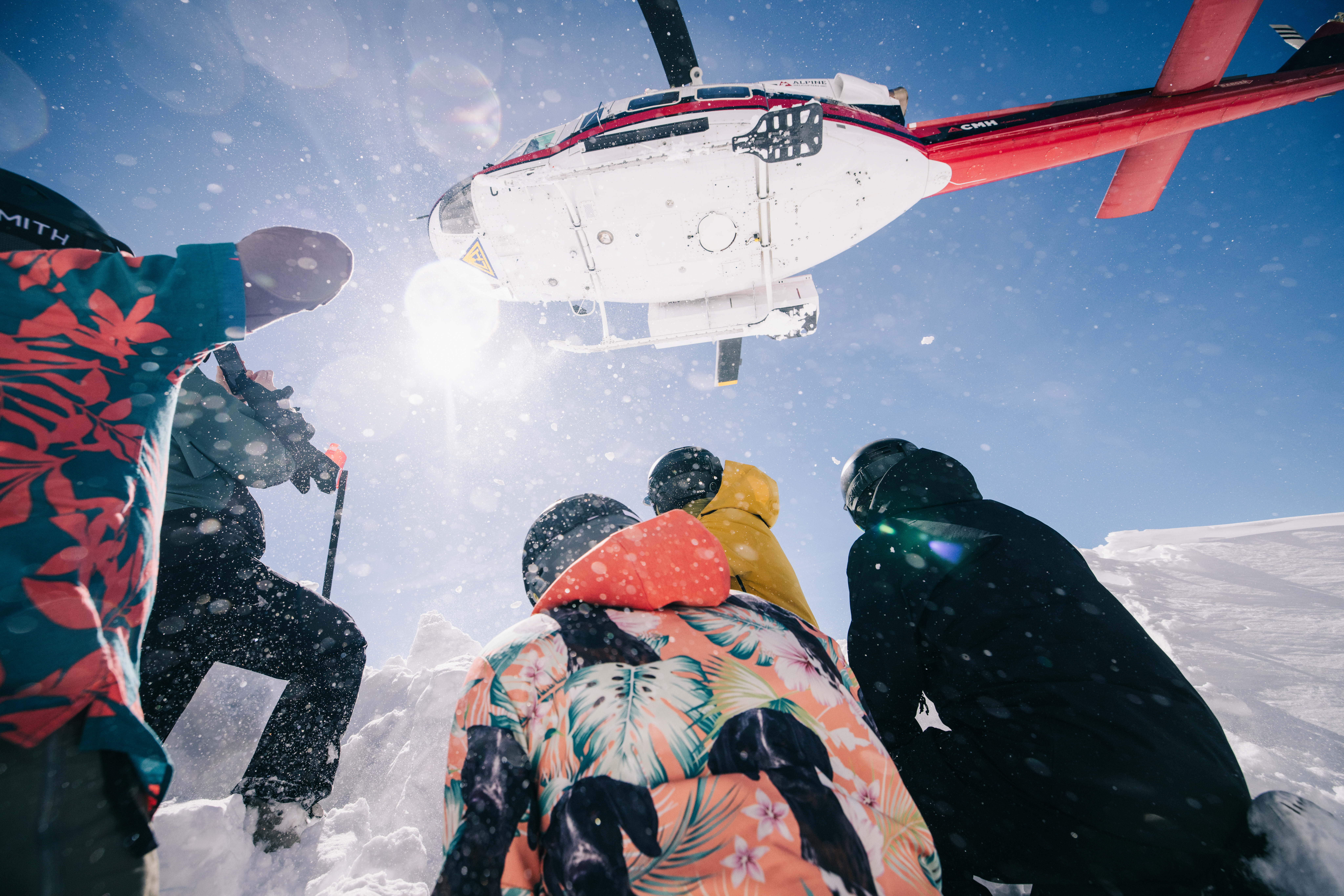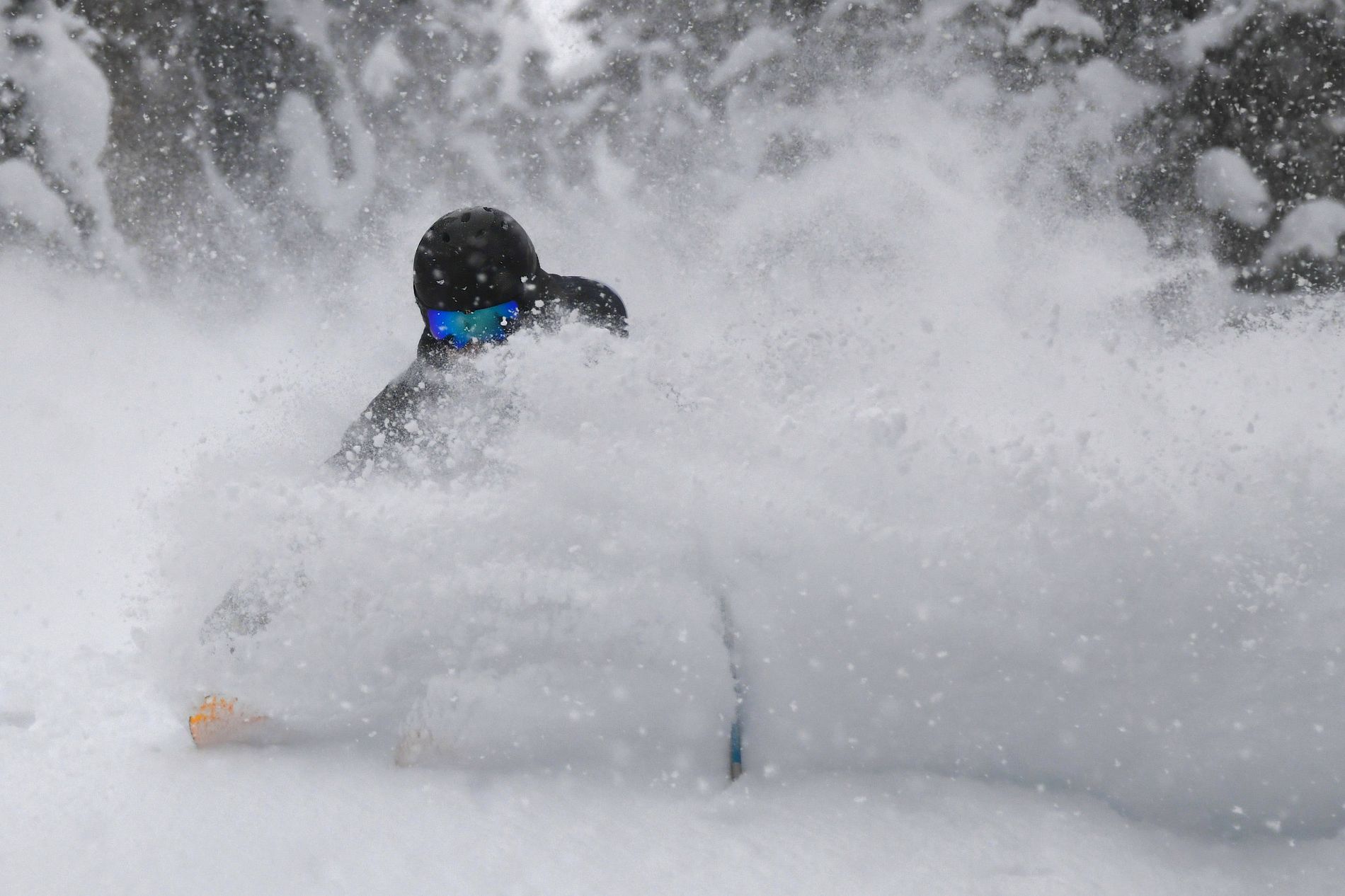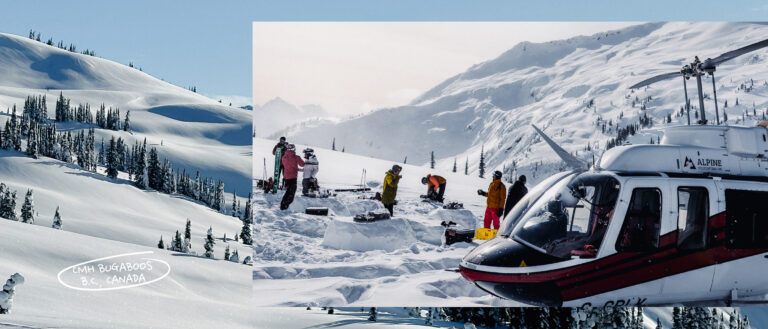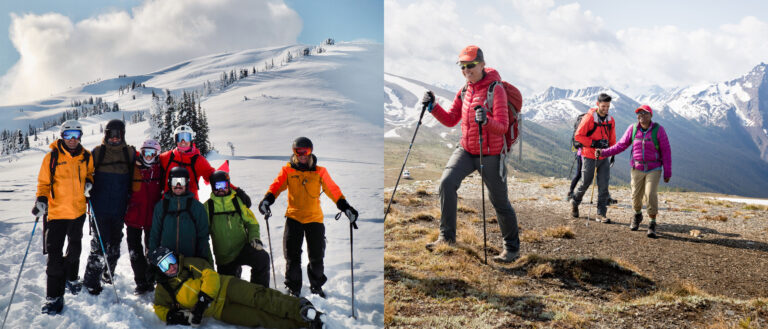Spoiler: there’s no single answer to that question. It’s different for everyone and depends on the day’s conditions, your body, your experience and ability, what ski inventory is available, and more.
The use of alpine skis and poles is included with every CMH heli-skiing trip (more on ski touring equipment and snowboards later).
When you arrive at our lodges, our on-site experts carefully consider a myriad of factors — including any preferences you’ve indicated on your wavier — and use their experience to narrow down the available choices before ultimately recommending a pair of skis that are suited to you, your trip, and your ski style.
Read on for some behind-the-scenes insight into what our equipment techs think about when making a recommendation.
Plenty to pick from
Gone are the days of skinny skis. Today’s ski technology is packed with lighter, floatier, more advanced all-mountain skis than ever before. Our 12 CMH destinations are stocked with a selection of more than 1,400 pairs — a collection that would make most ski quivers, well…quiver.
This mighty fleet has been carefully chosen to handle off-piste heli-skiing conditions of every variety. Our purchasers and suppliers have worked hand in hand for decades to make sure that the skis at our lodges are the best choices for our snow, our terrain, and of course our guests.
An educated choice
So, how to select the right ski when heli-skiing? The good news is you aren’t alone in the choice — in fact, we take care of the guesswork for you. All CMH destinations have a knowledgeable technician on-site who advises guests which skis from our collection are a good match.
There’s not one quick or straight-shot formula to do so, but there are a handful of main factors our team always thinks about.
We talked to CMH’s Manager of Retail Services, Michelle Oruski, for the scoop on how current conditions, ski width, length, cut, and a skier’s style and ability play into the decision. Michelle purchases all our skis and knows how the right equipment can take a regular ski day and propel it to ‘OMG-best-ski-day-of-my-life’ status.
Here are the main things that guide our thinking:
1) Fatter for float
First, width. Here’s where your weight matters most.
The wider the ski is underfoot, the more distributed your weight is – which means you’re effectively lighter per square centimetre/inch of ski surface. In other words, you’ll stay higher afloat in the snow. So, as you navigate untouched snow and powder shifts and moves underfoot; wider skis distribute your weight and add stability.
The resulting magical feeling of floating through powder is the whole point of your trip. If your ski is too narrow, you will not have your best day. Sinking sucks. Let’s not do that.
So, we consider your weight, plus the snow conditions. The deeper the powder, the wider your ski might be.
How wide? Our skis vary in width from 102 mm – 132 mm underfoot.
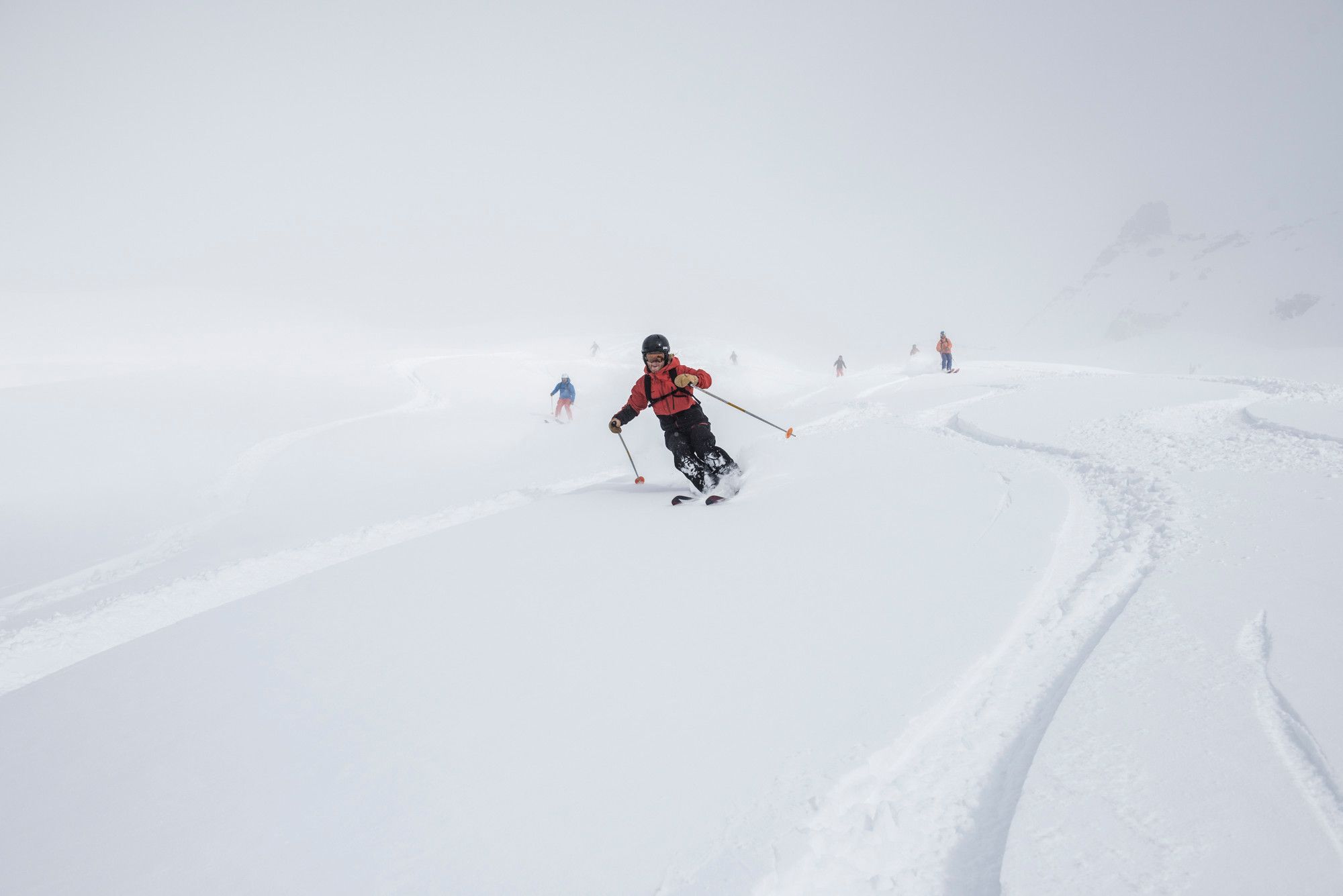
2) The long and the shape of it
Now, length and cut. Your skiing style and your ability affect the length and cut of ski you’ll need.
Above, we covered how powder skis keep you more afloat because they are wide. Well, when you’re afloat and moving higher up in the snow, you’ll also go faster. The longer your ski is, the more this effect will be accentuated and the faster you’ll go. So, the shorter the ski, the easier it is to control your speed and your turns.
Most adult powder skis come in lengths of 159 cm – 192 cm, depending on the width. An aggressive skier may enjoy the speed of longer skis, while a less experienced skier may feel tossed around on a long ski. Shorter lengths offer more maneuverability and are easier to turn. That said, at higher speeds, a shorter ski is less stable. We suggest erring on the shorter side if it’s your maiden voyage into deep powder.
The overall geometry of a ski — the amount of sidecut, rocker and camber it has — will affect how it turns. But don’t sweat these techy terms; you truly don’t need to know them. You’re in good hands with the guidance of our technicians.
The basics? A ski with a shorter turning radius is helpful in the trees, while a ski with a wider turning radius leans towards making big, wide-open cruisy alpine turns. Because you could ski a mix of trees, alpine and everything in-between on a CMH trip, we strategically stock skis that are good all-rounders.
In the words of longtime CMH Cariboos Shop Manager, Keith Brodski, “Our mid-width skis are like the Ford Explorers of the ski world. They can do everything and go anywhere, so you can’t really go wrong.”
Ski tech talk can be unnecessarily complicated, so we prefer to keep the process simple when helping you figure out the best combination of ski geometry to suit your individual situation. That rings true if you’re ripping steep trees or trying heli-skiing for the first time in our Powder Intro program.
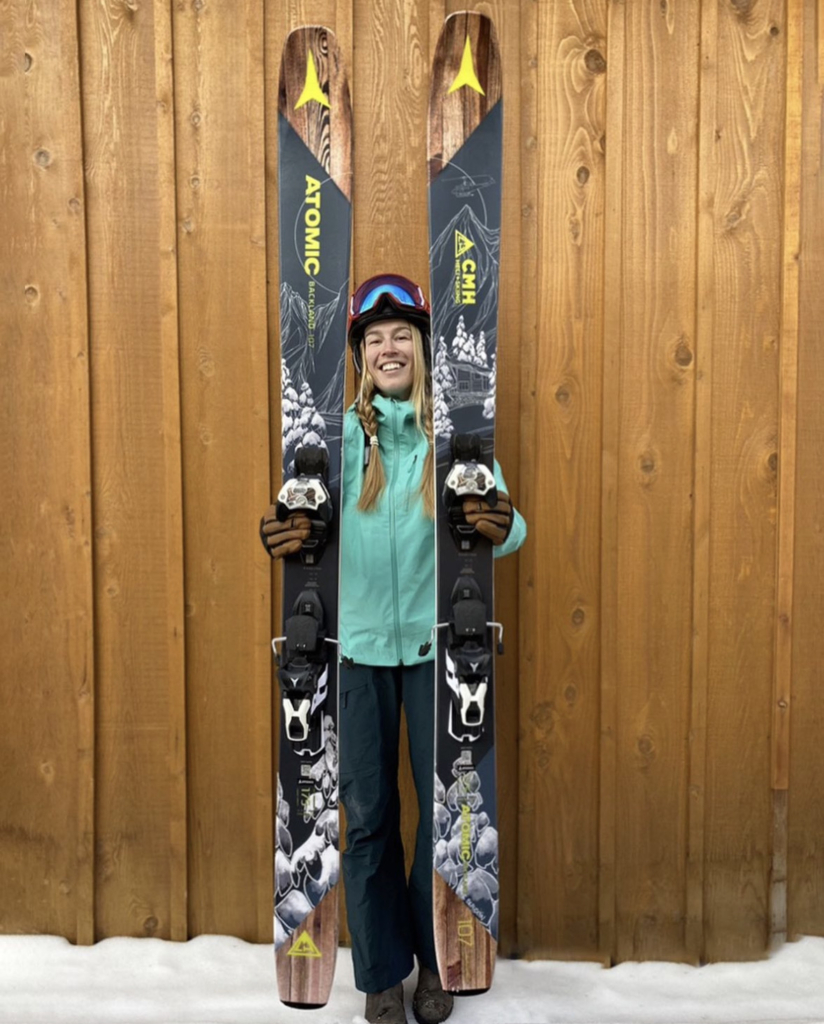
Ski jargon explained
If you do want to gear-geek out or expand your ski vocabulary, start here:
Sidecut: This is the amount a ski tapers from the tip to the waist and then widens again from the waist to the tail. Unlike a more heavily hourglass-shaped ski ideal for groomed runs, most powder skis sport a less-exaggerated side cut, which helps keep your turns looser and encourages your skis to float on powder snow.
Rocker: This is the amount the tip and tail of a ski are flared upward. A ski with a rockered tip will more effortlessly float on powder, while rocker at the tail makes for easier turning since less of the ski’s tail is in contact with the snow.
Camber: Rocker relates to the tip and tail of the ski, whereas camber is all about the middle section. Camber is an arching feature where the middle portion of a ski arches upward compared to the tip and tail. If a ski with camber is lying flat on a table, the tip and tail will touch the table while the middle section will arch upward and not touch. When you make a turn while skiing, your downward force pushes on the arch and creates a rebound of energy, much like a spring. Camber impacts how ‘lively’ a ski feels.
3) Look outside
Lastly, we think about weather and snow conditions. Our techs watch the forecast and chat with the guides to keep tabs on conditions. Just how deep is the snow today? Sometimes there will be a wallop of faceshot-worthy fresh stuff, and sometimes you’ll be cruising already-settled snow from a previous snowfall. Broadly speaking, the deeper the snow, you’ll want a ski that’s wider underfoot and on the shorter end of the scale.
Other condition-related factors we consider: is there a crust at a certain depth? What’s the snow’s texture at this time of year? Do the day’s conditions make it likely you’ll spend a lot of time skiing a particular type of terrain?
All these elements play into ski choice.
The bottom line
No matter the weather, your body or your ability, we have solid ski options to help you achieve heli-skiing bliss. We want you to enjoy the moment, and not to be worrying about your skis.
Heli-skiing should be about that otherworldly, unmatched sensation you get when floating on untouched snow — a feeling that we’re convinced can’t be found anywhere else.
Common questions
Which skis do you stock?
The available inventory at each destination differs for a number of reasons including which skis are best suited to the terrain and conditions typical of the area.
With that in mind, here’s a broad look at our current equipment lineup, plus other gear we provide.
Can I bring my own skis heli-skiing?
You can bring your own, of course, but 95% of our guests use skis and poles from our quiver. We encourage you to use our gear for a few different reasons.
Though we do everything to prevent it, every so often someone will permanently lose a ski in deep snow. Imagine the heartbreak of one of your favourite personal skis popping off and sliding beneath the surface, never to be found again. Better our skis than yours in that situation!
If you do opt to bring your own skis or snowboard, or if you’re joining us for a Touring or Fusion Trip where everyone brings their own skis, it’s good to be aware that scratches do sometimes happen when gear is being loaded and unloaded into the helicopter’s basket. If it does happen, consider it a brag-worthy conversation starter about that time you went heli-skiing.
Does CMH provide ski or snowboard boots?
No, we do not provide ski boots or snowboard boots. Boots are such an individual fit and personal preference that we don’t dare mess with the equilibrium of the ski equipment universe! You must bring your own ski boots.
We use the Atomic Warden 13 binding on all our skis. This binding is multi-norm certified, which means all alpine ski boots and many ski touring boots will fit into our bindings. If your boot has an ISO number listed on the outside of the boot, it will fit our bindings.
An important tip: ALWAYS bring your boots as a carry-on item if you’re flying. We can usually help you patch together the rest of a kit if your luggage is lost or delayed, but missing boots will equal missed heli-skiing (or very sore feet, at best). Even if you have to Jerry of the Day it and wear those bad boys clomp-clomp-a-stomping on the airplane, it’ll be worth it if your bags don’t show up on the other side.
What if I don’t like the skis you put me on?
If something isn’t feeling right when you’re out skiing, chat with your technician or your guide ASAP to see what’s possible. Don’t wait until the end of the trip! We want to improve your experience, STAT.
You aren’t locked into any one pair of skis for the duration of your time with us — you are more than welcome swap to another pair based on what’s available and not already in rotation. It may be the case that not every ski you want to try will be up for grabs, but we’ll do everything we can to find a better match.
Does CMH provide ski touring equipment?
No, we do not provide ski touring equipment. Those joining us on a Touring Trip must bring their own touring boots, touring skis, skins, and other equipment. If you’re on a Ski Fusion Trip (which is part ski touring, part regular heli-skiing), you must also bring your own alpine boots. Here’s a list of what to pack.
Does CMH provide snowboarding equipment?
We have a selection of powder boards that are available to reserve when booking. Or, you can bring your own. All snowboarders must bring their own boots, and there are a few other items we strongly recommend. Here’s a list of what to pack.
Can I go heli-skiing if I’m a telemarker?
The heli-skiing telemarker is a rare breed, but if your ability level is a good fit and your quads can hack it, you can do it! Tele-markers must bring their own boots and skis. We do not stock telemark skis.
